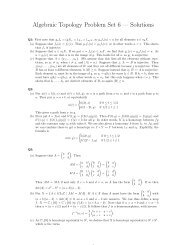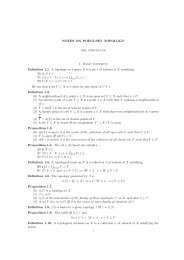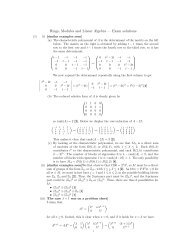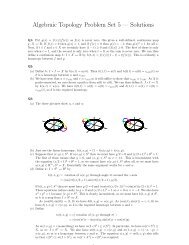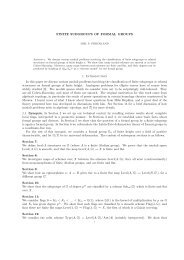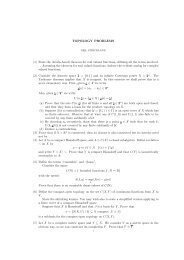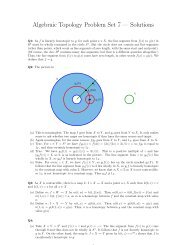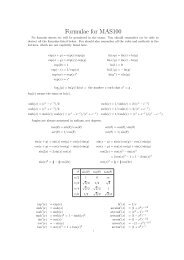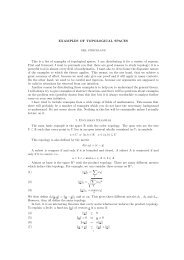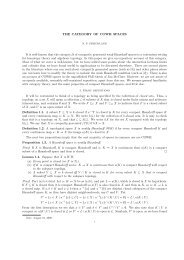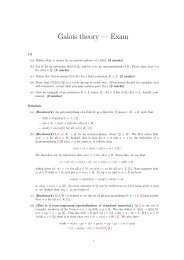Examinable material for Galois Theory - Neil Strickland
Examinable material for Galois Theory - Neil Strickland
Examinable material for Galois Theory - Neil Strickland
Create successful ePaper yourself
Turn your PDF publications into a flip-book with our unique Google optimized e-Paper software.
<strong>Examinable</strong> <strong>material</strong> <strong>for</strong> <strong>Galois</strong> <strong>Theory</strong><br />
General type of questions<br />
As in previous years, a large proportion of the questions will ask you to apply the general machinery of<br />
<strong>Galois</strong> theory to certain specific fields, especially cyclotomic fields, multiquadratic fields, cubic extensions<br />
of Q, or unusually nice quartic extensions of Q. Another common type of question asks you to consider a<br />
<strong>Galois</strong> extension where you are given certain in<strong>for</strong>mation about groups and intermediate fields, and you need<br />
to deduce other in<strong>for</strong>mation using the <strong>Galois</strong> correspondence. You should review all the questions of these<br />
types from the past papers and the notes.<br />
Compared to exams that you have taken in previous years, there will be more places where you need some<br />
creativity or ingenuity to find the right approach.<br />
Background from earlier courses<br />
The early sections of the notes are reminders of <strong>material</strong> that you should have covered in earlier courses.<br />
Specifically:<br />
• Almost all of Section 1 (Fields: definitions and examples) is covered by MAS333 (Fields).<br />
• Almost all of Section 2 (Vector spaces) is covered by MAS277 (Vector spaces and Fourier <strong>Theory</strong>).<br />
• The <strong>material</strong> in Section 3 (Ideals and quotient rings) is partly covered by MAS276 (Rings and<br />
Groups), and also appears in MAS333 (Fields), MAS337 (Rings and Modules) and MAS434 (Commutative<br />
Algebra) in varying levels of generality.<br />
• Most of the <strong>material</strong> in Sections 4 and 5 should also be familiar from MAS333 (Fields).<br />
The exam will not focus on any of this, but you will need it as background knowledge.<br />
Omitted sections<br />
In 2011-12, Sections 9 (Finite fields), 13 (Quartics), 14 (Cyclic extensions) and 15 (Extension by radicals)<br />
were not covered and will not be examined.<br />
I will not expect you to remember complex <strong>for</strong>mulae from Section 12 (Cubics), but I will expect you to<br />
understand the general method.<br />
Theorems and other results<br />
In the exam you will be asked to prove various results, which will be taken from the following list:<br />
• Proposition 1.25 (automorphisms of Q)<br />
• Proposition 1.29 (homomorphisms are injective)<br />
• Proposition 1.31 (L H is a subfield)<br />
• Proposition 4.42 (distinct roots <strong>for</strong> irreducible polynomials)<br />
• Proposition 5.10 (algebraic extensions)<br />
• Proposition 6.3 (<strong>Galois</strong> groups are groups)<br />
• Proposition 7.2 (biquadratic extensions)<br />
• Lemma 7.7 (subgroups of Σ p )<br />
• Corollary 7.8 (<strong>Galois</strong> group is all of Σ p )<br />
• Proposition 8.11 (<strong>Galois</strong> groups of cyclotomic fields)<br />
• Proposition 12.1 (Cubic extensions).<br />
There will also be unseen problems in which you need to find your own proofs of results that are not in<br />
the notes. Moreover, you will need to understand and be able to use many other results. In particular, you<br />
will need to know all the details of Theorem 11.1 (the <strong>Galois</strong> correspondence) and related results, but you<br />
will not be asked to prove them.<br />
1
Definitions<br />
You will be asked to give various definitions, which will be taken from the following list:<br />
• Definition 1.13 (subfield)<br />
• Definition 1.19 (homomorphism, isomorphism, automorphism)<br />
• Definition 2.18 (degree of an extension)<br />
• Definition 4.11 (irreducible polynomial)<br />
• Definition 4.15 (Eisenstein criterion)<br />
• Definition 5.5 (algebraic extension)<br />
• Definition 5.13 (split polynomial)<br />
• Proposition 6.3 (<strong>Galois</strong> group)<br />
• Definition 6.8 (normal extension)<br />
• Definition 8.1 (cyclotomic polynomial).




